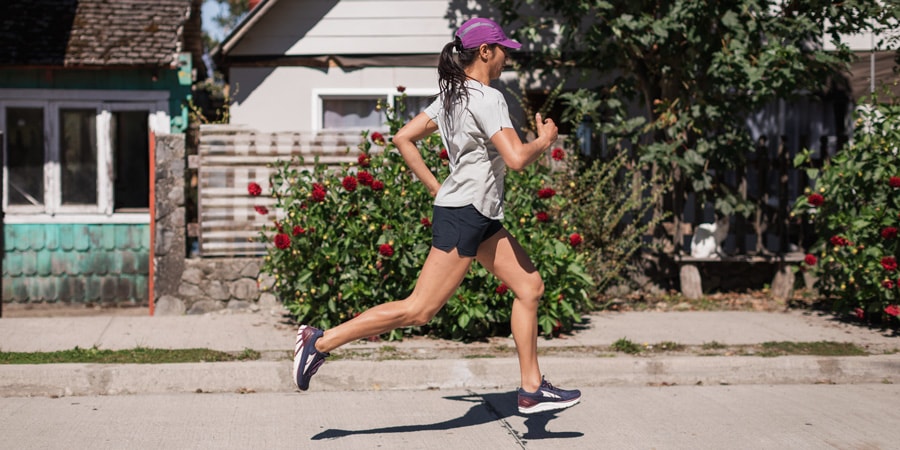Runners know that to become a better runner, you have to log miles and put in the work. But not all that work has to come from hitting the pavement. You can improve your performance by incorporating a simple exercise routine into your running regimen to build strength and endurance.
This exercise plan targets leg muscles that power your stride, works your core so you can maintain good form, and helps support the parts of your body (knees, hips, lower back) that are prone to running injuries. The workout can complement any running schedule, whether you're preparing for a half-marathon or just running for fun.
Here's a quick, general overview on how to train for running:
- Increase your power: Strengthen the muscles you use most: quads, glutes, hamstrings and abdominals.
- Build stamina: Just as you increase mileage over time, train your muscles to perform better over an extended period of time.
- Cross-train: Find an aerobic activity that you enjoy doing (swimming, biking or yoga, for example) to give your legs a break from the repetition of running.
Before beginning any training plan, check in with your doctor or certified training professional.
Training Schedule for Running
This exercise plan is designed to complement your running days. Start it about six to eight weeks before a race that is shorter than a half marathon. Start earlier (about eight to 12 weeks before a scheduled race) if you're eyeing a half marathon or a longer race. Do these exercises a few times a week, tapering off as you increase running miles. As you get closer to your race day, try to do the exercises at least once a week to keep the benefits.
Training Exercises for Running
Keep the following in mind as you train:
- Modify exercises if something doesn't feel good.
- Train slowly at first and work at your own pace.
- Increase the repetitions or add more resistance or weight as your training progresses.
Warm up: Start your workout with five to 10 minutes of easy cardio activity. This could be a short session on a treadmill or stationary bike, doing jumping jacks or jogging.
Here are a few guidelines for all of the exercises:
- Inhale during initial exertion, then exhale as you return to the starting position. Breathe normally during faster exercises.
- Initially, rest for 60 to 90 seconds at the end of each exercise (unless otherwise noted). As you feel fitter or want more of a cardio challenge by keeping your heart rate up, shorten your rest time to between 30 and 45 seconds
- Do the full set of exercises, rest for two minutes and repeat the complete set once or twice.
Walking Lunge with Rotation Exercise
Warm up your quads, hips and lower back with this exercise that gets you into your running stance and helps improve your balance.
Prop: None
- Stand with your feet slightly apart.
- Step one foot forward into a lunge. Your back knee should drop at a 90-degree angle to the ground. Your forward knee should also be at a 90-degree angle.
- As you step forward, rotate your body to the side in the direction of your lead knee. Have arms at chest height, slightly elevated from your sides.
- Drive up and through your forward leg to take the next lunge step. Your back knee should now be out front.
- Repeat 10 times each side for a total of 20.
Tips and modifications: If you don't have enough space, you can stay in one spot and alternate your legs. Make it easier by keeping your back leg straight. Make sure that your knees do not go inward and stay in a straight line with your foot and hip.
Hip Roll Exercise
Hip strength plays an important role in keeping your knees aligned as you accelerate forward. By strengthening the muscles of your hip, which include your glutes, you can prevent your knees from rotating inward at each stride. This will also reduce the likelihood of knee pain.
Prop: Chair, if needed for balance
- Stand on your left leg.
- Lean your body forward at your hips, keeping back straight and lift your right leg back behind you, slightly off the ground.
- Rotate (roll) your hip away from your standing foot.
- Keep your body in a straight plane as you roll your hips back.
- Repeat 10-15 times on each side.
Tips and modifications: If it's too hard to balance, hold on to the back of a chair or keep your toes on the ground.
Squat Reverse Lunge with Knee Raise Exercise
This exercise works the primary muscles used in running: quads, glutes and calves.
Prop: None
- Stand with your feet shoulder-width apart.
- Squat like you're sitting back into a chair.
- Stand up and step one leg back into a reverse lunge. Your knees should be at a 90-degree angle to the floor. Do not let your knees go inward, keep them in line with feet.
- As you come out of that reverse lunge, bring your back knee forward and lift it so your knee is now at a 90-degree angle in front of you.
- Raise onto the toes of your standing leg.
- Return to a squat and repeat on the other leg.
- Do 10 repetitions on each leg.
Tips and modifications: Avoid arching your back. To modify the exercise, you can touch your foot back rather than going all the way into a deep lunge.
Lateral Ski Jump Exercise
This dynamic exercise targets your quads, glutes and hamstrings and builds explosiveness for greater speed. The lateral movements will also improve your balance and agility.
Prop: None
- Stand with your feet hip-width apart and knees slightly bent, balancing on one leg
- Jump to the side, landing on the other leg. Think about landing softly with your knee slightly bent.
- Then jump to the other side, landing on the other leg.
- Swing your arms sideways across your body like a speed skater.
- Repeat 15 on each side for a total of 30.
Tips and modifications: If you find this exercise too challenging, make smaller jumps to the side, move slower or touch your toe to the ground rather than keeping it off the floor.
Lift Exercise
This exercise engages your core, glutes, shoulders and calves. It improves the full extension of your leg, which helps you propel yourself forward as you run.
Prop: A medium-resistance exercise band
- Use a resistance band that you can secure at about ankle height.
- Stand sideways to where the band is anchored and position yourself so that when you grab the end of the band with both hands, there is tension in the band.
- Rotate your torso upward, pulling the end of the band at an upward angle across the front of your torso; let your feet pivot until you are facing in the opposite direction with your arms straight in front of your body. Straighten the leg closest to the band while pushing up onto the toe of that foot.
- Return to the starting position while maintaining an even tension in the band.
- Through this entire motion, your core muscles should be powering the movement; your shoulders should stay square and your hips should remain aligned; your elbow and wrists should also remain as straight as possible.
- Do this 20 times; then do the same on the opposite side for 20 more reps.
Tips and modifications: Adjust band resistance level by shortening it to increase resistance or lengthening it to ease the resistance. Your goal is to feel fatigued at the end of your reps, but not so fatigued that you struggle to finish them.
Hip Clock Exercise
This exercise targets your glutes and hamstrings. The stronger your hips are, the better you're able to control your knees.
Prop: None
- Stand with your weight balanced on your left leg and that knee slightly bent.
- Keep your back straight and weight centered over the standing knee.
- Imagine that you're at the center of a clock. Lift and extend your right leg, reaching forward toward 12 o'clock.
- Bring your leg back to the center.
- Repeat the movements toward the 3, 6 and 9 o'clock positions. As you reach for each position, stay balanced over the standing leg and don't let your hips shift side-to-side.
- Switch to the other leg and repeat; do 5 to 8 sets on each leg.
Tips and modifications: Keep your hips level and push into the ground with your standing foot for balance. Make smaller leg movements if you feel off balance.
Bird Dog Exercise
Core strength will help you protect your lower back, support your body and keep you in good running form.
Prop: None
- Start on your hands and knees in a balanced position, with your head looking slightly downward. Tuck your chin slightly to keep your neck in a neutral position.
- Exhale and tighten your abs. Imagine that you're sucking your belly button into your spine, while balancing a glass of water in the small of your back throughout the exercise.
- Raise your right arm and your left leg until they are lined up with your spine. Your spine should be aligned from the top of your head to your heel and your hips shouldn't dip; breathe naturally as you do this step.
- Slowly return to the start position, then repeat on the other side (raising your left arm and right leg).
- Do 10 raises, alternating the leg/arm combo each time.
Tips and modifications: Keep your abs and core sufficiently tight to prevent movement in your lower back. If you struggle to lift an arm and leg simultaneously, extend the leg first and then extend the opposite arm after you're balanced.

